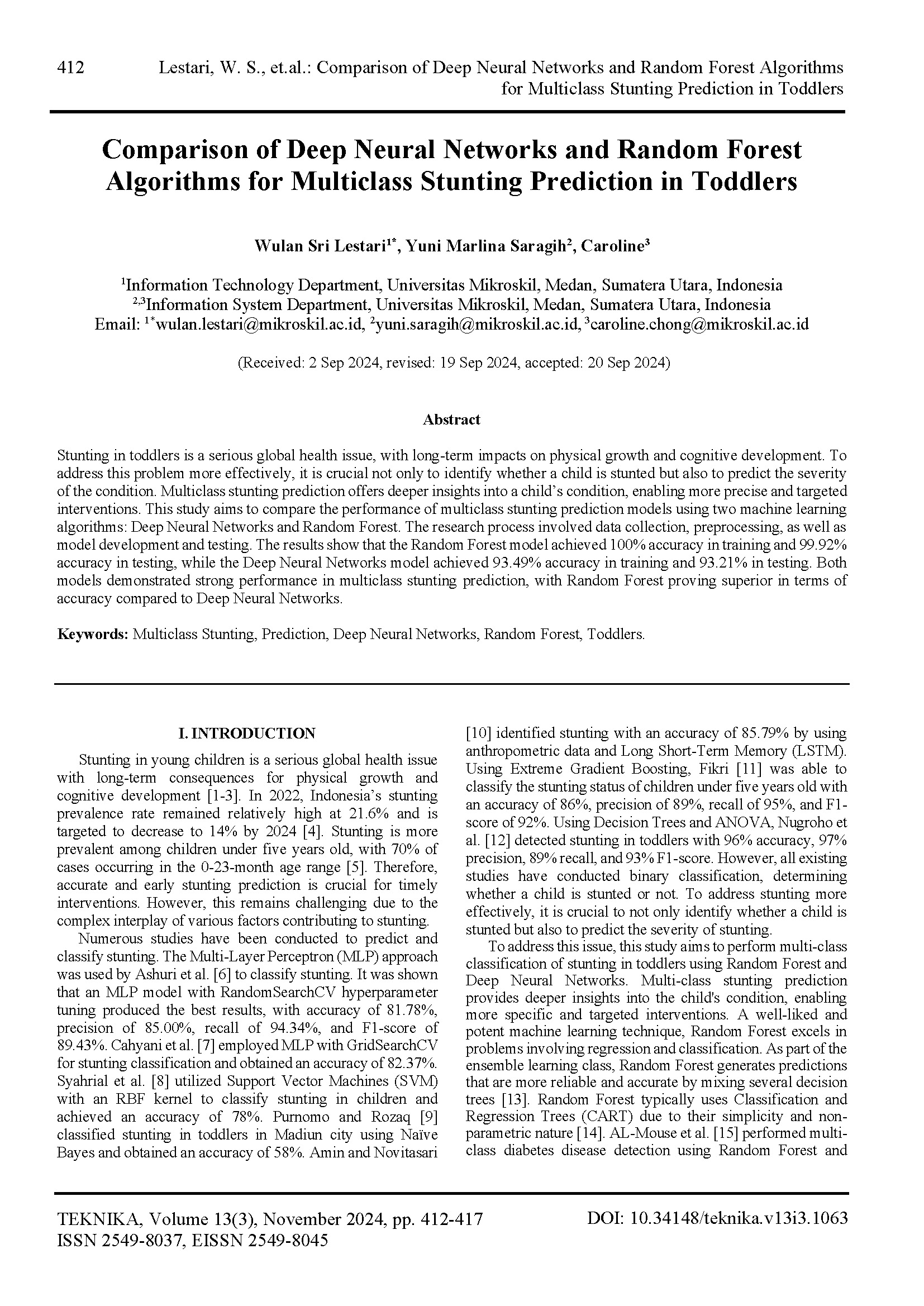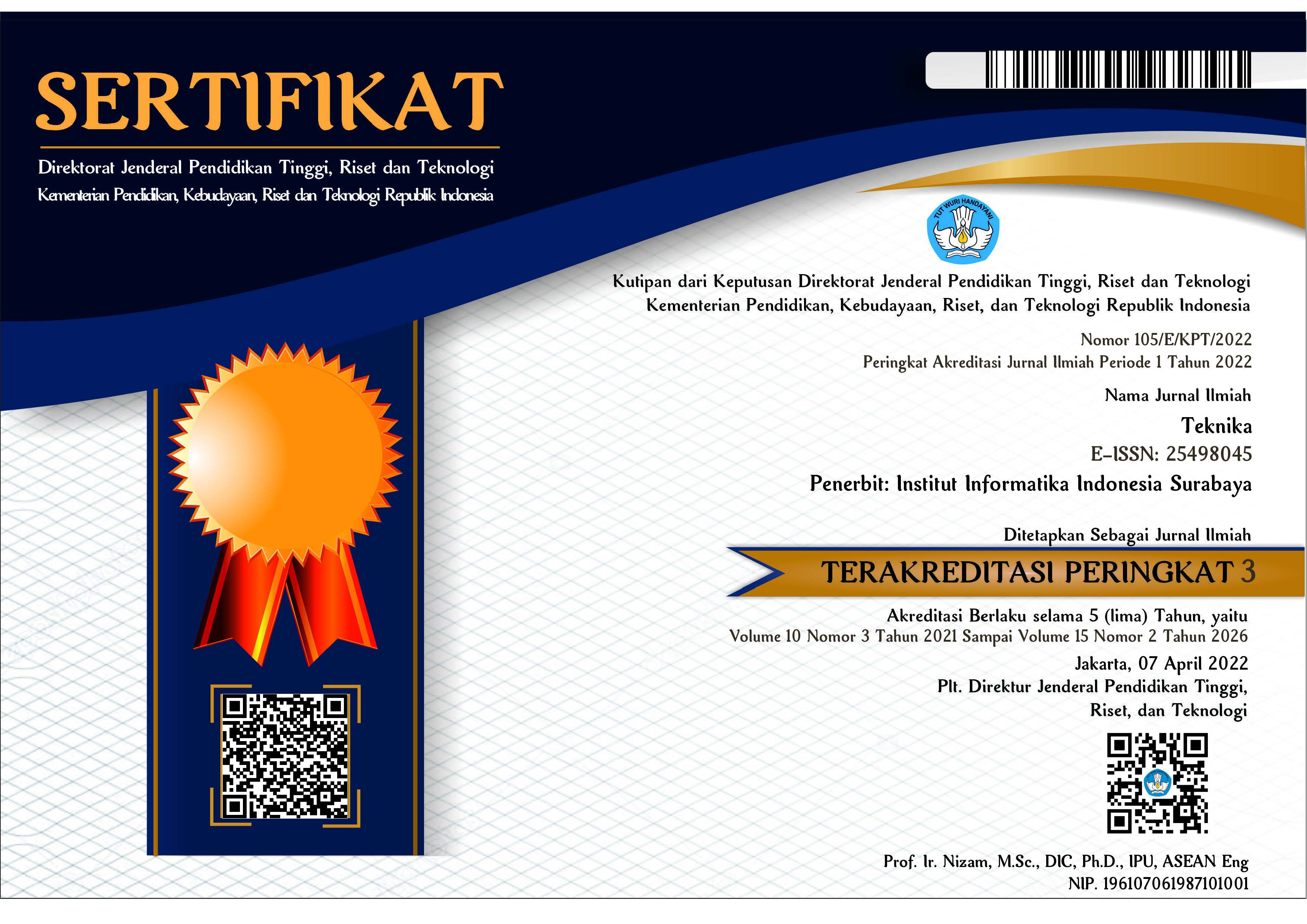Comparison of Deep Neural Networks and Random Forest Algorithms for Multiclass Stunting Prediction in Toddlers
DOI:
https://doi.org/10.34148/teknika.v13i3.1063Keywords:
Multiclass Stunting, Prediction, Deep Neural Networks, Random Forest, ToddlersAbstract
Stunting in toddlers is a serious global health issue, with long-term impacts on physical growth and cognitive development. To address this problem more effectively, it is crucial not only to identify whether a child is stunted but also to predict the severity of the condition. Multiclass stunting prediction offers deeper insights into a child’s condition, enabling more precise and targeted interventions. This study aims to compare the performance of multiclass stunting prediction models using two machine learning algorithms: Deep Neural Networks and Random Forest. The research process involved data collection, preprocessing, as well as model development and testing. The results show that the Random Forest model achieved 100% accuracy in training and 99.92% accuracy in testing, while the Deep Neural Networks model achieved 93.49% accuracy in training and 93.21% in testing. Both models demonstrated strong performance in multiclass stunting prediction, with Random Forest proving superior in terms of accuracy compared to Deep Neural Networks.
Downloads
References
M. Yunus, M. K. Biddinika, and A. Fadlil, “Classification of Stunting in Children Using the C4.5 Algorithm,” JOIN (Jurnal Online Informatika), vol. 8, no. 1, pp. 99–106, Jun. 2023, doi: https://doi.org/10.15575/join.v8i1.1062.
M. de Onis et al., “Prevalence thresholds for wasting, overweight and stunting in children under 5 years,” Public Health Nutrition, vol. 22, no. 1, pp. 175–179, Oct. 2018, doi: https://doi.org/10.1017/s1368980018002434.
J. R. Khan, J. H. Tomal, and E. Raheem, “Model and variable selection using machine learning methods with applications to childhood stunting in Bangladesh,” Informatics for Health and Social Care, pp. 1–18, Apr. 2021,
doi: https://doi.org/10.1080/17538157.2021.1904938.
Kemenkes RI, “Prevalensi Stunting di Indonesia Turun ke 21,6% dari 24,4%,” www.kemkes.go.id. 2023. https://www.kemkes.go.id/id/rilis-kesehatan/prevalensi-stunting-di-indonesia-turun-ke-216-dari-244
H. Pohan, M. Zarlis, E. Irawan, H. Okprana, and Y. Pranayama, “Penerapan Algoritma K-Medoids dalam Pengelompokan Balita Stunting di Indonesia,” Public Knowledge Project PLN, vol. 3, no. 2, pp. 97–104, Nov. 2021, doi: https://doi.org/10.53842/juki.v3i2.69.
P. I. Ashuri, I. A. Cahyani, and C. S. K. Aditya, “Klasifikasi Penyakit Stunting Menggunakan Algoritma Multi-Layer Perceptron,” MIND (Multimedia Artificial Intelligent Networking Database) Journal, vol. 9, no. 1, pp. 52 – 63, Juni 2024, DOI : https://doi.org/10.26760/mindjournal.v9i1.52-63
I. A. Cahyani, P. I. Ashuri, and C. Sri, “Stunting Disease Classification Using Multi-Layer Perceptron Algorithm with GridSearchCV,” Sinkron, vol. 9, no. 1, pp. 392–401, Jan. 2024, doi: https://doi.org/10.33395/sinkron.v9i1.13245.
Syahrial, R. Ilham, Z. F. Asikin, and S. Surya, “Stunting Classification in Children’s Measurement Data Using Machine Learning Models,” Journal La Multiapp, vol. 3, no. 2, pp. 52–60, Mar. 2022, doi: https://doi.org/10.37899/journallamultiapp.v3i2.614.
A. Rozaq and A. J. Purnomo, “Classification of Stunting Status in Toddlers Using Naive Bayes Method in the City of Madiun based on Website,” Jurnal Techno Nusa Mandiri, vol. 19, no. 2, pp. 69–76, Sep. 2022, doi: https://doi.org/10.33480/techno.v19i2.3337.
F. M. Amin and D. C. R. Novitasari, “Identification of Stunting Disease using Anthropometry Data and Long Short-Term Memory (LSTM) Model,” Computer Engineering and Applications Journal, vol. 11, no. 1, pp. 25–36, Feb. 2022, doi: https://doi.org/10.18495/comengapp.v11i1.395.
M. Fikri, “Klasifikasi Status Stunting Pada Anak Bawah Lima Tahun Menggunakan Extreme Gradient Boosting,” Merkurius : Jurnal Riset Sistem Informasi dan Teknik Informatika, vol.2, no.4, Juli 2024, DOI: https://doi.org/10.61132/merkurius.v2i4.159
A. Nugroho, H. L. H. S. Warnars, F. L. Gaol, and T. Matsuo, “ Trend of Stunting Weight for Infants and Toddlers Using Decision Tree,” IAENG International Journal of Applied Mathematics, vol. 52, no. 1, Maret 2022.
A. Cutler, D. R. Cutler, and J. R. Stevens, “Random forests,” in Ensemble Machine Learning, pp. 157–175. Springer, 2012.
A. Liaw, M. Wiener et al., “Classification and regression by randomforest,” R news, vol. 2, no. 3, pp. 18–22, 2002
A. Al-Mousa, L. AlKhdour, H. Bishawi, and F. AlShubeliat, “Multiclass Diabetes Detection Using Random Forest Classification,” May 2023, doi: https://doi.org/10.1109/jeeit58638.2023.10185679.
L. Senbagamalar and S. Logeswari, “Genetic Clustering Algorithm-Based Feature Selection and Divergent Random Forest for Multiclass Cancer Classification Using Gene Expression Data,” International Journal of Computational Intelligence Systems, vol. 17, no. 1, Feb. 2024, doi: https://doi.org/10.1007/s44196-024-00416-9.
K Saminathan, B Sowmiya, and D. M. Chithra, “Multiclass Classification of Paddy Leaf Diseases Using Random Forest Classifier,” Journal of Image and Graphics, pp. 195–203, Jun. 2023, doi: https://doi.org/10.18178/joig.11.2.195-203.
W. S. Lestari and M. Ulina, “Optimizing Deep Neural Networks Using ANOVA for Web Phishing Detection,” Teknika, vol. 13, no. 1, pp. 71–76, Feb. 2024, doi: https://doi.org/10.34148/teknika.v13i1.758.
H. Aljuaid, N. Alturki, N. Alsubaie, L. Cavallaro, and A. Liotta, “Computer-aided diagnosis for breast cancer classification using deep neural networks and transfer learning,” Computer Methods and Programs in Biomedicine, vol. 223, p. 106951, Aug. 2022, doi: https://doi.org/10.1016/j.cmpb.2022.106951.
R. P. Pradana, “Stunting Toddler (Balita) Detection (121K rows),” Kaggle.com, 2024. https://www.kaggle.com/datasets/rendiputra/stunting-balita-detection-121k-rows (accessed July. 02, 2024).























